The BEST Chicken Stock
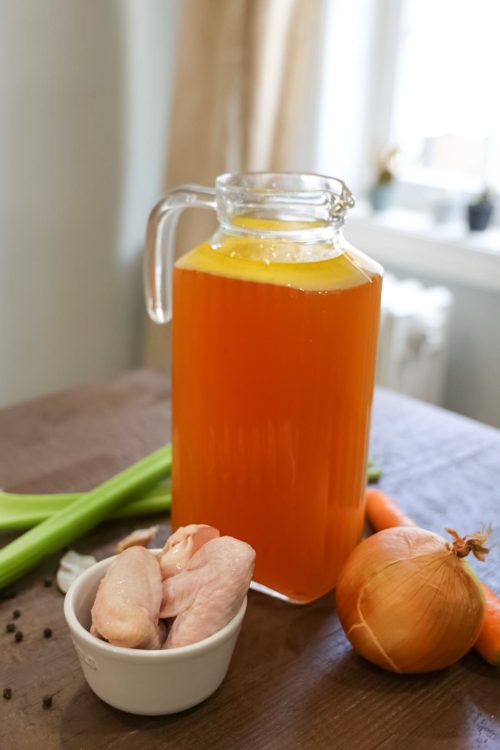
This is the ultimate chicken stock. With just a few pounds of chicken bones, some feet and wings, and a few aromatics lying around in your kitchen, you’ll be able to create a stock that is rich yet clear, deep and gelatinous – a stock that will act as the backbone of all your chicken-based soups.
Table of Contents
Ingredients & Equipment
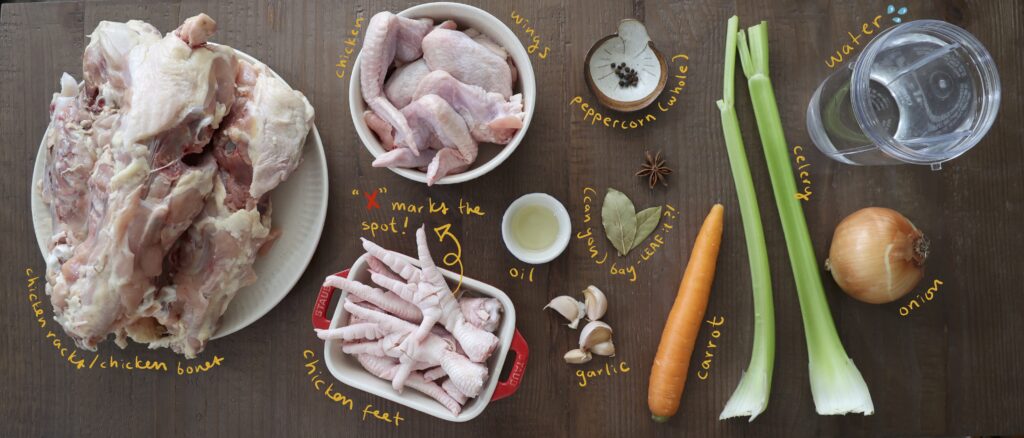
You will need:
- Chicken: 6 lb chicken rack/bones, 1 lb chicken wings/wing tips, 5-6 chicken feet
- Herbs and spices: 2 bay leaves, 5 cloves of garlic, 5-10 whole peppercorns, 1 thumb ginger (optional), star anise (optional)
- Vegetables: 1 carrot, 2 celery ribs, 1 medium onion
- Etc: 1 tablespoon vegetable, canola, or peanut oil
- Water: 2.5 litres

Detailed Instructions
STEP 1: Clean your chicken
Preheat your oven to 400°F.
Remove large chunks of fat, internal organs, and bloody bits from the chicken racks. Wash the racks, wings, and feet well. Dry chicken well. We dry the chicken well so it is easier to hit that deep, golden colour when roasting..
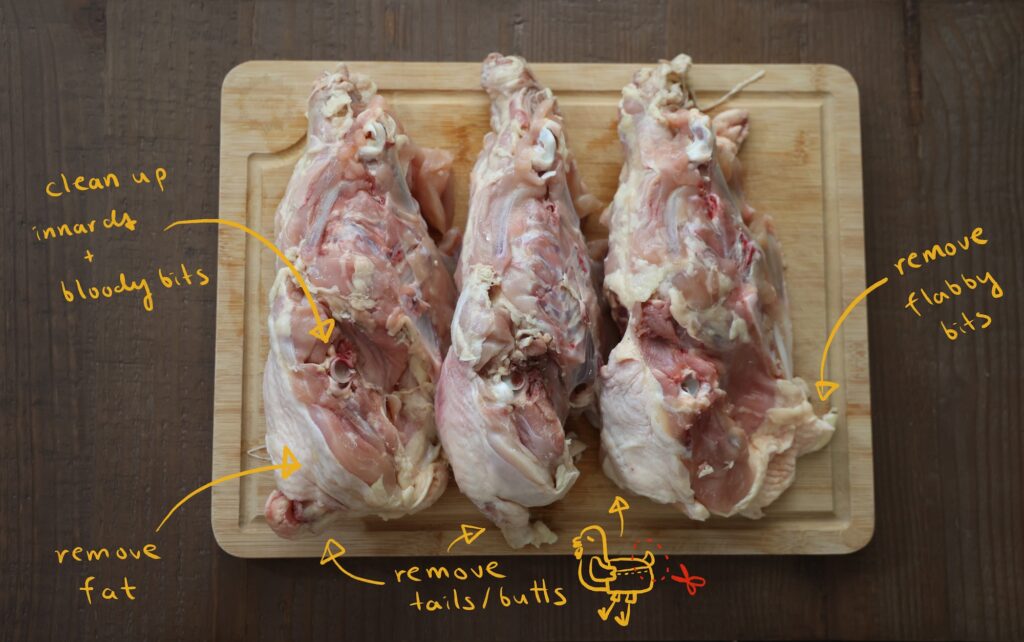
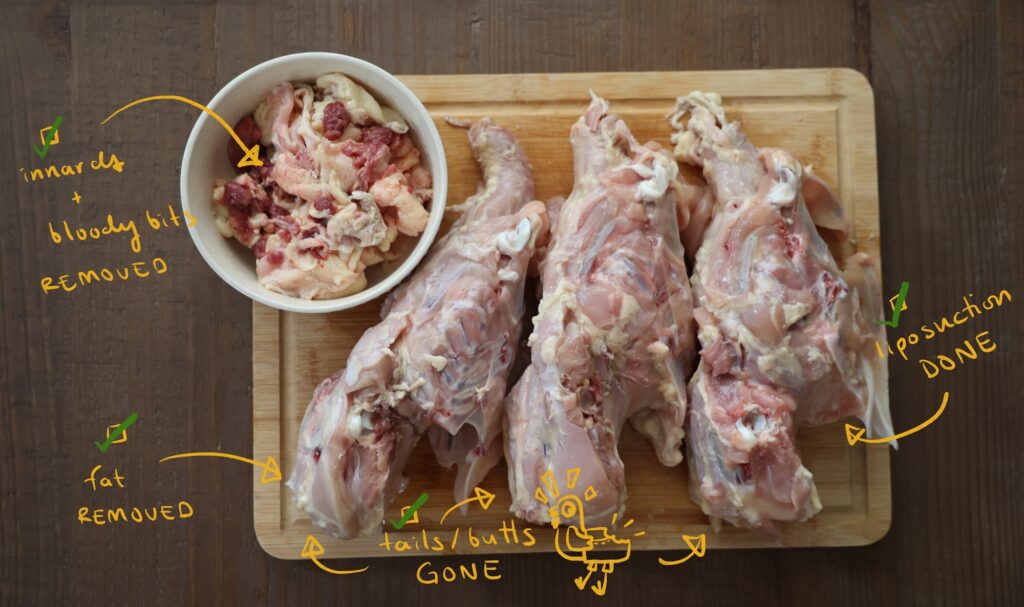
STEP 2: Roast the chicken bones, wings, and vegetables
Lightly coat your chicken and chopped vegetables with oil and 1 tablespoon of corn syrup or milk powder.

Oil 2 baking pans and spread the chicken bones, chicken wings, and vegetables across the pans in a single layer. This helps achieve an even browning.
Roast for 50 minutes, flipping the chicken once or twice, until the chicken is golden brown.

Why do we toss the chicken in corn syrup or milk powder? We toss our chicken in corn syrup or milk powder because the sugars in these ingredients (glucose in corn syrup and lactose in milk powder) help brown our chicken. Glucose and lactose are “reducing sugars” that accelerate the Maillard reaction, the magic behind why food browns. When you take your first bite into sweet fried potato fries or the crisp crust of a well-cooked steak, you have the Maillard reaction to thank! You can substitute corn syrup or milk powder for other ingredients with these reducing sugars, including honey, which contains fructose and glucose. |

Pour out the rendered grease at the bottom of the pan. Set aside to use for cooking. Pour hot water on the roasting pan and scrape up the browned bits. Reserve to add to the stockpot.
STEP 3: Simmer the chicken
In your stockpot, add the roasted chicken and 2.5 litres of water (or enough to just cover the chicken). Leave the vegetables out for now. Bring everything to a boil, then reduce to a very gentle simmer.
Simmer gently for 2 hours, skimming occasionally in the first half hour to remove scum that rises to the top.
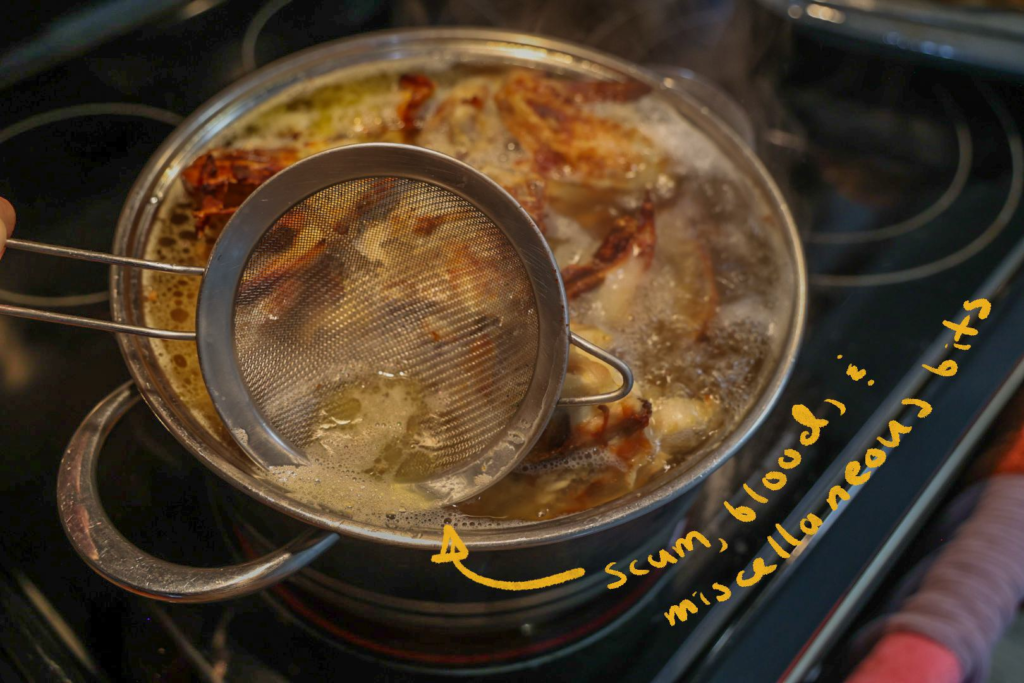
How You Can Tell When You’re Simmering
When your stock is boiling, you’ll see many big bubbles burble all across the top of your pot, and your stock will be constantly moving and agitating the ingredients. When your stock is simmering, you may see a few streams of tiny, champagne-like bubbles – but your overall pot should remain calm and undisturbed.
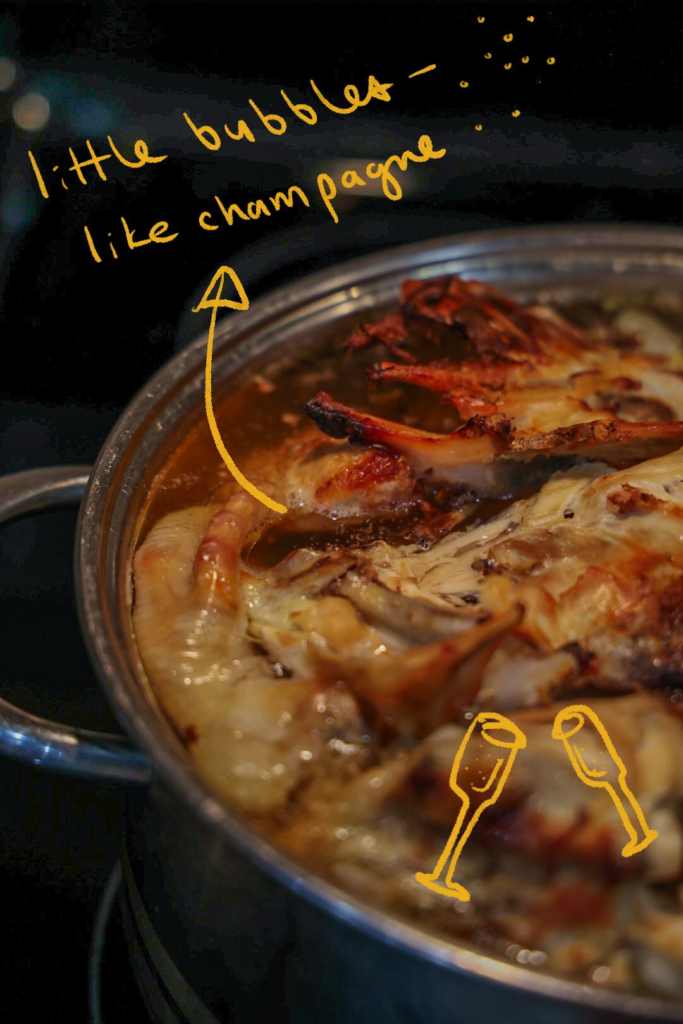
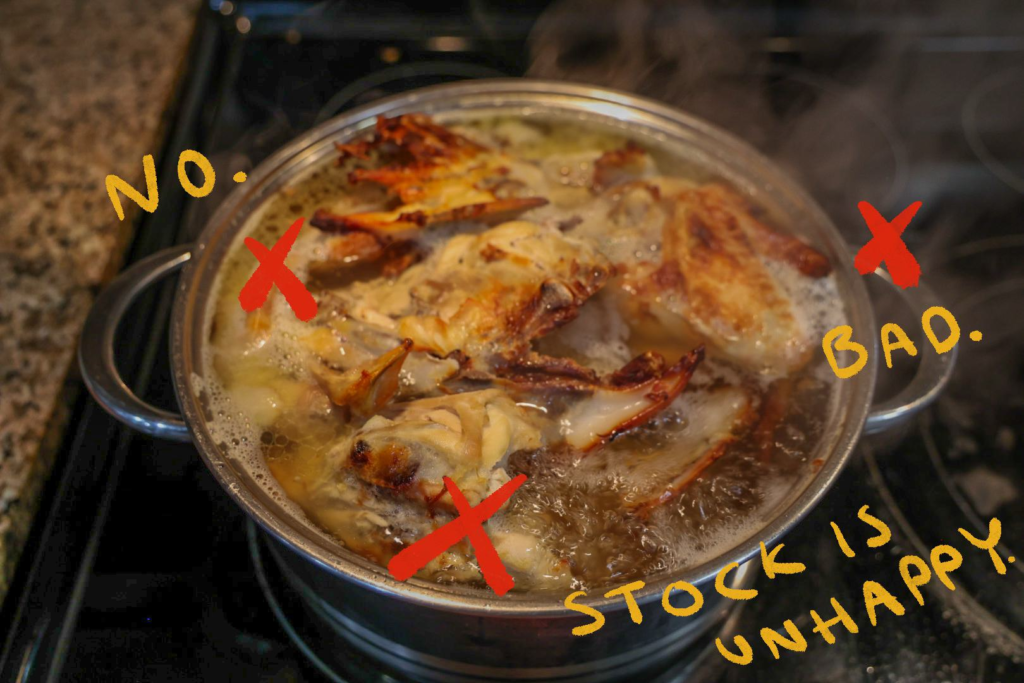
Why do we simmer, not boil? YOU MUST SIMMER LOW AND SLOW. It’s cost me gallons of murky stock, but I’ve learned that stock making is not a race. I used to think there wasn’t much difference between simmering and boiling. I thought one just cooked the food faster. If the only thing standing between me and a bowl of chicken noodle soup is the cook time, let’s crank the heat up to eleven and get to slurping sooner! Boiling water is hotter and more turbulent than simmering water. Water boils at 212°F (100°C). Water simmers at 185°F to 205°F (85°C to 96°C). The heat and vigour of a full boil will emulsify fats, proteins, and other gunk with your water, resulting in a greasy, bland, and (if you care about visuals) cloudier stock. Note: The rule to simmer doesn’t apply to all everything. East Asia, for example, has a penchant for boiling the ever-loving shit out of bones. Recipes will have you intentionally emulsify fat and protein with the water, making a gorgeous, velvety, milk-white stock. More on this later. |
STEP 4: Add the aromatics
After two hours of simmering and skimming, add the roasted vegetables, bay leaves, and peppercorns to the stockpot. Simmer for one more hour.
Optional: Add a thumb of (sliced) ginger and one star anise. Ginger will give your stock a slightly warm, almost peppery flavour. Star anise will impart a slightly sweet flavour, like an earthy liquorice.
Not Too Long on the Vegetables A few factors make simmering the vegetables the whole time not only unnecessary for a successful broth, but potentially harmful as well:
|
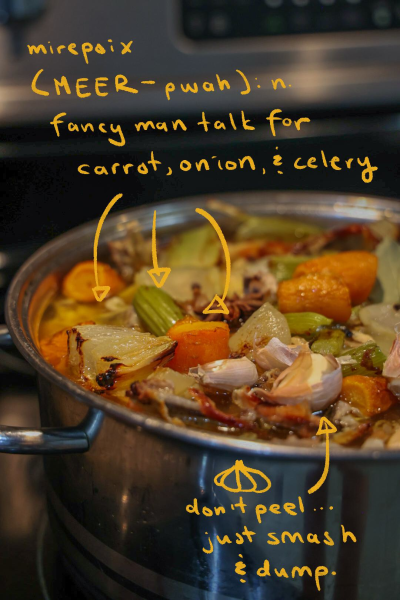
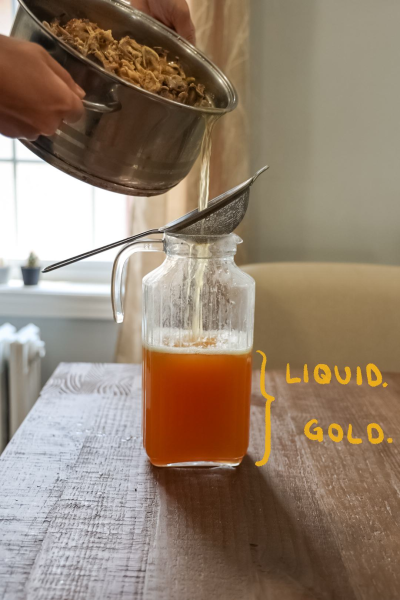
STEP 5: Strain and enjoy!
Strain your stock using a fine strainer or cheesecloth. To be extra fancy, you can put a cheesecloth over a strainer and strain through both.
Sip and say “ahhhhhhh!”
STEP 6 (OPTIONAL): Skim the fat
After your stock has cooled down to room temperature, place it in the fridge. Once it’s been there for a few hours, the fat will float to the top and solidify into a “fat cap.” Use a spoon to remove this solidified fat for a cleaner-tasting stock. Reserve for another use, like sautéing veggies!
Skip this step if you like the richness the fat adds to your stock. Or, remove a portion of the fat cap to control the amount of fat left in your stock.
FAQ’s
- Why does my stock taste greasy and bland?
You did not heed the bolded, italicized instructions to simmer, not boil.
- Why is my stock bitter?
Possible causes of bitter stock are:
- Overroasting the vegetables. If you roasted your vegetables for too long, you might have charred them, which could give them a bitter taste that seeps into your soup.
- Adding the wrong vegetables to the stock. Avoid adding cruciferous vegetables like broccoli, cauliflower, radish, cabbage, and kale. These vegetables have sulfur-containing compounds called glucosinolates, which make them incredible sources of nutrients, but which also contribute to their distinctive and at times bitter flavour. We don’t want to let that bitterness into our stock.
- Not removing leafy bits, onion skins, and veggie butts: I don’t have a good word for the bottoms of vegetables from which the roots shoot off. But don’t include them. Same with the leafy bits at the top of celery and fennel, and onion skins. Some people say a limited quantity of onion skin may help add flavour and colour, but I don’t think it’s worth risking your stock for.
- How do I fix a bitter stock?
You can balance bitterness with counteracting flavours, such as sugar, nutritional yeast, miso paste, red wine/apple cider vinegar, or lemon juice.
Add one teaspoon of your counteracting agent, taste, and repeat until you’re happy with the result!
- How can I level up my stock?
I am so glad you asked *Sheldon voice right before he takes off his pants and shows the audience Uranus*.
Here are a few things you can do to bring your stock to the next level:
- Add umani bombs. Add ingredients like miso paste, kombu (a kelp used in Asian cooking), shittake mushrooms, and mushroom powder to increase the savouriness of your stock.
- Increase the chicken-to-water ratio. The higher the chicken-to-water ratio, the more intense your stock flavour will be. The lowest ratio I recommend is a 1:1 ratio, meaning the weight of your chicken should be at least as much as the weight of your water. If your ingredients permit, increase that ratio to get a stronger stock. This will be easier if you have a deep stock pot.
- Should I salt my stock?
I suggest not salting your stock, especially if you’re using it as an ingredient in another dish and not as the end product in and of itself. This lets you retain maximum flexibility.
If you do salt your stock, do so at the end, after straining. Salting your stock before it has finished cooking can lead to an overly salty final product.
Keep in mind: You can always add more salt to perk up a light stock; it’s much harder to desalinate briny broth.
However, with that said…
- How do I make my stock less salty?
If you find your stock too salty, you can:
- Add 1 or 2 halved potatoes and cook for 15 minutes or so to absorb some of the salt.
- Balance the salt with acid, like a tablespoon of vinegar or lemon juice
- Balance the salt with sugar
Recipe
The BEST Chicken Stock
Equipment
- stock pot at least 12 quarts
- 1 skimmer
Ingredients
Chicken
- 6 lb chicken racks/bones
- 1 lb chicken wings
- 5-6 chicken feet
Vegetables
- 1 carrot cut to 1 inch chunks
- 2 celery ribs cut to 1 inch chunks
- 1 onion cut to 1 inch chunks
Rub
- 2 tbsp neutral oil e.g. vegetable, canola, peanut
- 2 tbsp corn syrup or milk powder
Herbs and Spices
- 2 bay leaves
- 5 garlic cloves
- 5-10 whole peppercorns
- 1 thumb ginger optional
- 1 star anise optional
Etc
- 2.5 litres water
Instructions
- Prepare chicken. Preheat oven to 400°F. Make a deep cut into the chicken feet palms. Remove fat, internal organs, and bloody bits from your chicken racks. Wash racks, wings, and feet. Dry well.
- Roast chicken and vegetables. Coat chicken and vegetables with oil and corn syrup. Lay everything in a single layer across 2 baking pans. Roast for 50 minutes, flipping once in the middle, or until both sides of chicken are golden brown. Pour out rendered oil and reserve for another use (keeping it in can muddy your stock).
- Simmer - without aromatics. In a stockpot, add water and roasted chicken. Bring to a boil, then reduce to a gentle simmer. Simmer for 2 hours. Optional: occasionally skim scum off the top.
- Simmer - with aromatics. Add herbs, spices, and roasted vegetables. Simmer for 1 more hour.
- Strain and enjoy! Strain your stock using a strainer or cheesecloth (or both). Sip and say “ahh!”
- Skim the fat (optional). Once the stock cools and the fat has congealed at the top, take a spoon and skim off as much fat as desired.

